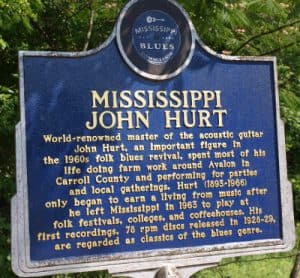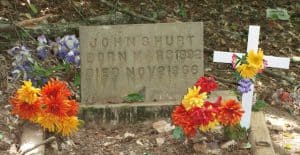Even for seasoned “blues travelers”, there are destinations integral to the historical tapestry of early African-American music that unfortunately languish in obscurity. For many, the “blues” conjures images of wide, endless cotton fields, cypress groves, and tin roofed shacks withering under the blistering heat of the Mississippi summer. And while these images are not unfounded, it is precisely this shared cultural image of the Mississippi Delta that draws attention away from other blues sites equally integral to the story of this music. One of these places is Avalon, Mississippi, the hometown of an unsung hero of acoustic folk and blues music, Mississippi John Hurt. For any fan of blues, history and especially fans of Mississippi John Hurt, it is well worth a visit.
Located halfway between Greenwood and Grenada, Avalon sits on the eastern edge of the Delta, in Carroll County. And like John Hurt’s song Avalon Blues suggests, “New York’s a good town, but it’s not for mine.” As such, John lived most of his life in Avalon, a town too small to even be listed on maps in the early 1900’s. The journey to the museum site is a literal trip back in time. Unlike the starkness of the empty fields and highways of the Delta, Avalon is a forested area where the prime thoroughfares are still dirt roads, carved through the hill country clay. Turning right off of State Road number 7 driving north from Greenwood, one must wind their way through a maze of old roads that bore silent witness to the passage of time, as horses and mule drawn buggies gradually gave way to motor vehicles. On the way to the Valley Store, the Avalon general store where John would buy his groceries and enjoy the company of neighbors on the store’s porch, one will pass the steep hill leading to the cemetery where Hurt and his family rest in the family cemetery. John’s original log cabin, long lost to time, stood on this hill as well, in addition to the original St. James Church, also no longer standing. The Valley Store, with its bare wooden walls and hand painted Coca-Cola sign, is also integral to the John Hurt legend as it is where amateur musicologist Tom Hoskins was pointed in the direction to John’s house, just a mailbox or two up the hill, on A.R. Perkins land.

Just down the road from the Valley Store, a short distance from the new St. James Church, one can find the Mississippi John Hurt Museum, a museum dedicated to the life and music of the gentle songster who enraptured the world during the 1960’s Folk Revival with his syncopated fingerpicked rhythms and kindly voice. The Museum is built inside of John’s home, a humble three room shack with an endearingly lopsided porch and a tin roof. Situated not quite a mile from where the house originally stood, the story of how it fell into the possession of Mary Frances Hurt, John’s granddaughter, is a tale of providence and maybe even fate. Mary tells a story about how through a series of serendipitous events, her grandfather’s home came into her possession. Having not visited Mississippi in quite some time, Mary was suddenly taken with the need to revisit her grandfather’s home. As she stood there, contemplating the forces that had brought her back home, the man who currently owned the land John’s house sat on remarked that “God had told him” that Mary would be there that day. He gave Mary the house. With 5,000 dollars donated to her by a local Carrollton banker who remembered “Daddy John” playing guitar for his mother, Mary had the house moved to a two acre plot of land just up the road, with the intention of restoring the house as a museum, a beacon to musicians and fans alike.
The museum itself is a stellar piece of history. It is quite an experience to walk on the old wooden boards and feel the breeze through the trees, cooling slightly the stifling Mississippi heat. This is the climate in which the great bluesmen were born and bred. The building itself is John’s original home, a humble three room shack befitting of a gentle farm hand with an amazing affinity for the guitar. The three rooms are filled to the brim with items belonging to or reminding one of “Daddy John”, graciously donated by fans and locals who knew him (Maxwell House coffee cans and railroad spikes are in abundance). Many of these fans travel to Avalon once a year for the Mississippi John Hurt Music Festival.
The festival feels more like a homecoming than a concert. Fans sit outside of John’s house, enjoy barbecue, pick guitars, and enjoy with Mary the joy of newfound friendship. Musicians play any number of classic John Hurt songs such as Spike Driver’s Blues, Coffee Blues and Louis Collins, to gospel tunes such as I Shall Not Be Moved and the immortal, bawdy Candyman. The turnout is sometimes small, but Mary believes that “everyone who is supposed to be here, is.” What the festival periodically lacks in turnout is made up for by the open hearts of all who put forth the effort to come out. Visiting John’s house and gravesite isn’t the easiest of journeys, but it is by far one of the most significant pilgrimages a blues fan or fan of Mississippi John Hurt can make.

